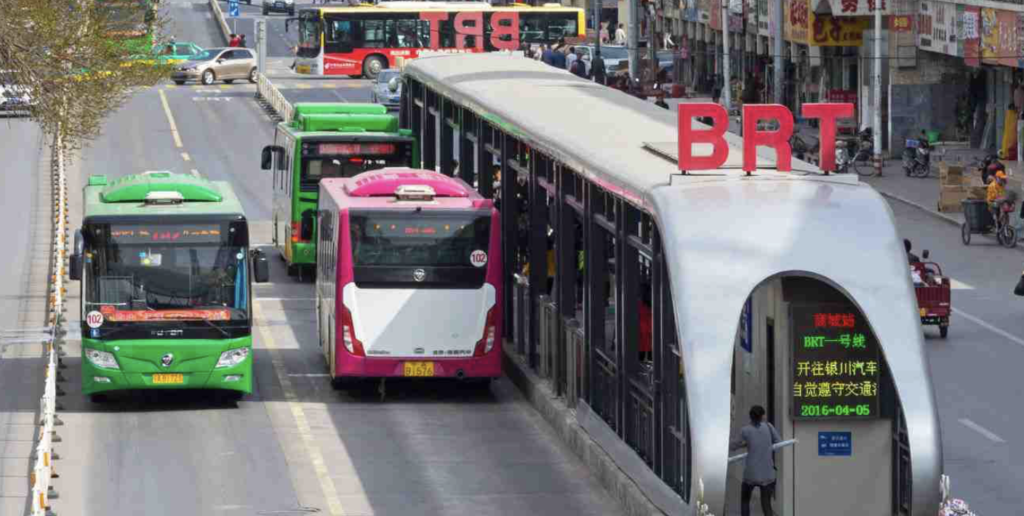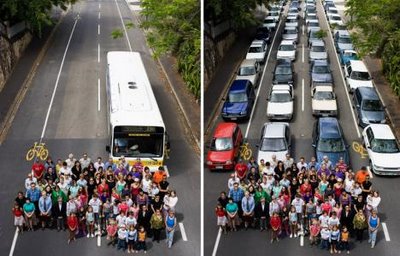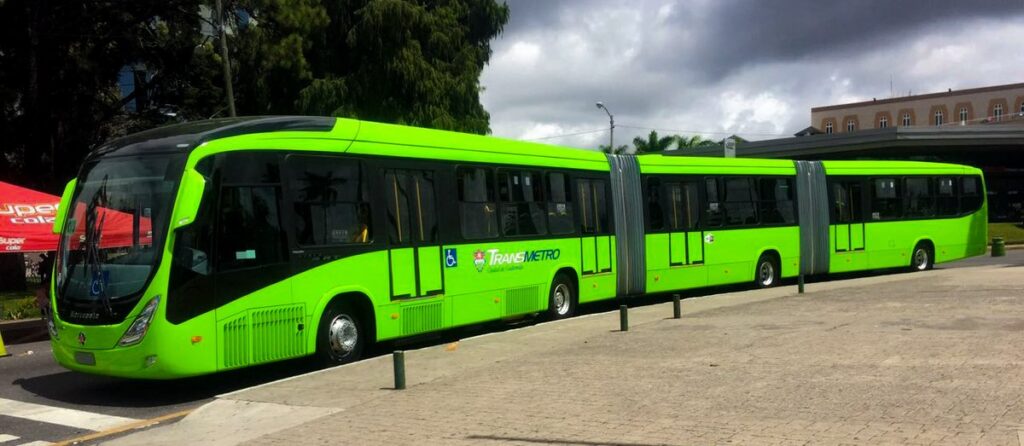I was reminded recently how much easier it is to remember facts and arguments if you explain them to someone else after reading them yourself.1 So, when I read a Streetsblog article about transportation nerdery recently, I decided to summarize its argument—partly for the half-dozen people who end up reading this, but mostly for myself.
Today’s nerdy topic is BRT, which my computer wants to autocorrect to “Be right there!” but actually stands for Bus Rapid Transit. I’ll get to that in a bit, but first I’m going to back up—way, way up.
The point of any kind of transit, whether it’s a bus or subway or giant MAGA pickup truck, is to move people from one place to another. Since we operate within the laws of physics, we can’t fit everybody’s personal vehicle onto the roads at once without making highways infinitely wide (and yes, they’ve been trying that in Texas). The only way, and I mean the ONLY way to efficiently move city-sized numbers of people around is with some kind of mass transit.
Once you’ve gotten over that mental hump (and some people never will), the practical question is which kind of transit—to use the terminology, which “transit mode”—is best for a particular situation. As seen above, even a rattling smoggy city bus is orders of magnitude more efficient than individual cars. Then you’ve got commuter rail, light rail, subways, and even weirder methods. To decide which one to use, how much it’s going to cost should be at or near the top of your list of considerations.
I see you lunging for the Comment button, because every time I talk about the cost of mass transit, there’s an automatic response: “Mass transit isn’t supposed to make money, Kevin! It’s a public good! Down with capitalism!” I agree with all of that. But it still costs money, and in our underfunded country, it’s extremely important to be smart about spending limited public funds.2 Subways are cool, but also hyper-expensive, and you can probably imagine how a subway might bankrupt a city if it didn’t have a LOT of daily users to help pay for it. In a less extreme example, an under-used commuter train can cost so much to run that it passively drains money from the rest of the city’s transit system, no matter how popular it is. (This is sadly the case with Austin’s Red Line, but that’s a topic for another day.)
There’s a name for this math problem: “transit-supportive density.” You need a certain number of people living and working per square mile for it to make sense to run transit through that area.3 And the more expensive the transit, the more people you need to support it. Check this table:
| Transit mode | Cost per mile | Pop. density (people per acre) |
| Bus | <$1M | 10+ |
| Light rail | $150-$350M | 28+ |
| Subway | $300M-$2B | 47+ |
Those estimates vary *widely* but you get the idea. A plain-vanilla bus line costs very little to build (buses + stops) and doesn’t need much population density to be financially viable. Light rail costs much, much more to build and operate; a subway, even more than that. This is, in a nutshell, why a city like Austin can never have a NYC-style subway system—it just isn’t built for it.
Finally, I’m getting to the subject! Somewhere in between normal buses (cheap) and light rails (expensive) you’ve got something called “bus rapid transit,” or BRT for short. The definition of BRT is a bit flexible, but boils down to a bus line that’s been built for speed and efficiency. Most often this includes some or all of the following:
- A dedicated bus-only lane for at least part of the route
- “Signal priority,” ie. traffic lights that let buses go before cars
- Higher frequency (10–15 minutes) so you don’t need to check a schedule to use it
- Self-payment terminals so you can just tap your card or phone to pay the fare
On top of this, the bus itself might be sexier—extended lengths with multiple entry points; “level boarding” so wheelchair users can roll on; Wi-Fi networks; and so on.
It’s all very cool stuff! And even if your BRT includes everything from the wish list above, it’s still way cheaper than installing the rails and power lines you need for light rail. That means the “transit-supportive density” for BRT is way lower. Since most American cities have very low population density compared to the Amsterdams or Copenhagens of the world, that means BRT can be an attractive option.
So the point of the Streetsblog article is that BRT is, or should be, a very useful Goldilocks option—“BRT often can cost 20 percent of a light-rail system but can capture 80 to 85 percent of light rail riders.” That’s a sweet deal that brings a lot of mass-transit benefits to cities or areas that otherwise wouldn’t qualify for them, financially or logistically. If it’s “real” BRT—meaning most of the checklist items above, instead of just one or two—then it’s a viable alternative for a lot of applications.
Explainer done! Back to your regularly-scheduled whatever-this-blog-is.
- This wasn’t news to me; I work in instructional design! (Hire me.)
- Conservatives have hijacked the argument to spend government funds wisely—a very reasonable opinion!—to argue for cutting government funding entirely. You’ll notice I’m not arguing we should cut anything.
- An uncomfortable truth: this means that a typical suburban subdivision will almost never be good for mass transit.


